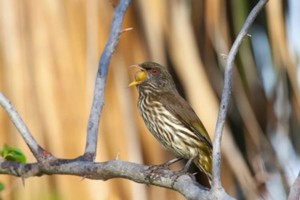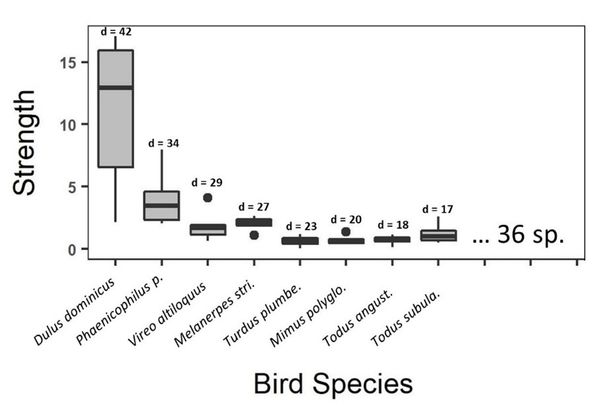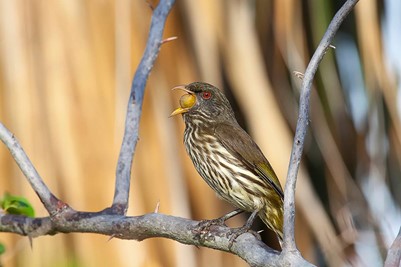
Report from a BOU-funded project
If a bird poops in the forest, but no one is around to hear it, does it make a sound? This, we cannot say for sure, but it very well might make a new tree! Birds play a key mutualistic role with plants in the process of seed dispersal in terrestrial ecosystems across the world, especially in tropical forests where frugivorous birds are the most common mode of propagule movement (Howe and Smallwood 1982). Given that dozens, sometimes hundreds, of taxa can carry out feeding-dispersal relationships in any particular landscape, viewing these communities as a network permits nuanced analyses of the role of particular species as well as the properties of the system as a whole (Saavedra et al. 2014; Fricke et al. 2017). Determining species’ roles within mutualistic networks can provide vital information for targeted conservation efforts that account for the interdependence of species linked through processes such as seed dispersal (Vizentin-Bugoni et al. 2021). Nevertheless, relatively few empirical data sets exist to tackle the complex challenges. Furthermore, there is a strong reliance on observations of foraging data that is presumed to represent seed dispersal patterns, but rarely are the two investigated in tandem.
We set out to investigate the biodiversity and mutualistic relationships of frugivorous birds and plants in the Cordillera Central of the Dominican Republic. We sampled six sites on private lands in the vicinity of the town Jarabacoa, representative of the fragmented state of the mid-elevation humid forests (i.e., “bosque montano-bajo”) covering much of the country. We monitored these sites continuously over a full year period with 21 visits to each site to monitor the phenology of 1,805 marked plants and bird abundance through surveys. By conducting focal foraging observations on plants with ripe fruits, we recorded 7,697 frugivory interactions between 53 plant and 44 bird species.
Despite the involvement of a diverse assemblage of birds in seed dispersal, four resident frugivorous bird species were found to account for 85% of all interactions in the data set: Palmchat (Dulus dominicus, Dulidae), Hispaniolan Woodpecker (Melanerpes striatus, Picidae), Black-crowned Palm Tanager (Phaenicophilus palmarum, Phaenicophilidae), and Black-whiskered Vireo (Vireo altiloquus, Vireonidae). Further analysis of interaction frequency data showed that these were also reflected by the strength of these species in the networks, with the Palmchat playing a particularly disproportionate role in seed dispersal (Figure 1).

Figure 1 The relative importance of bird species (i.e., strength) in the local networks based on the sum of their proportional contributions to interactions recorded for each plant species. “d” denotes degree, or the number of plant taxa the species was recorded to disperse.
To follow up our field studies, we took on a forensics approach to recover, isolate, and sequence DNA from bird droppings from the environment to test some of the assumptions of networks derived from visual observation to determine whether foraging patterns are an accurate representation of realized seed dispersal.
At three of our six sites, we deployed and monitored a grid of 40 seed traps spread evenly across the site on our phenology transects simultaneously with our other observation protocols. From these traps, we recovered over 2,000 plausible seed samples/clusters with the appearance of dispersal by birds or other animals (i.e., visible faecal matter or removed pulp). We carried out DNA extractions using a silica-column method on 950 randomly selected seed samples (González-Varo et al. 2014). From these samples, we are using PCR and sequencing of the COI mitochondrial marker to “barcode” the residual DNA leftover on the seed samples to identify the taxa responsible for dispersing it.
PCR and sequencing work is ongoing, however, from our first round of sequenced samples we have encountered some interesting results. As expected, the majority of our samples have produced sequences consistent with the Palmchat and other generalist frugivores. However, in our first 48 samples, we have already detected two instances of non-avian seed dispersers as well. These include the Jamaican Fruit Bat (Artibeus jamaicensis) dispersing Piper aduncum and a lizard (Anolis sp.) dispersing a Royal Palm (Roystonea hispaniolana) seed. Both these dispersal relationships are consistent with incidental observations from the field. Nevertheless, the avian community is still expected to account for the vast majority of dispersal events. We expect to find more varied contributions of birds in terms of the habitats to which they deliver seeds, and further resolution of the spatial information of dispersal events will allow us to resolve the functional differences of among avian dispersers beyond their quantitative contributions to seed dispersal. Additionally, the laboratory methods will allow us to discover species links that had previously gone undetected, expanding both the resolution of our data set as well as providing a basis with which to evaluate the biases of observation-derived networks.
Funding
Spencer Schubert (PhD Candidate) was awarded an ornithological research grant for £1,966 in 2019 for a project entitled ‘Linking frugivory to seed dispersal: testing predictions from plant-frugivore networks through molecular identification of avian seed dispersers’.
References
Fricke, E.C., Tweksbury, J.J., Wandrag, E.M. & Rogers, H.S. 2017. Mutualistic strategies minimize coextinction in plant–disperser networks. Proceedings of the Royal Society B 284: 20162302. VIEW
González-Varo, J.P., Arroyo, J.M. & Jordano, P. 2014. Who dispersed the seeds? The use of DNA barcoding in frugivory and seed dispersal studies. Methods in Ecology and Evolution 5: 806-814. VIEW
Howe, H.F. & Smallwood, J. 1982. Ecology of seed dispersal. Annual Review of Ecology and Systematics 13: 201-228. VIEW
Saavedra, F., Hensen, I., Beck, S.G., Böhning-Gaese, K., Lippok, D., Töpfer, T. & Schleuning, M. 2014. Functional importance of avian seed dispersers changes in response to human-induced forest edges in tropical seed-dispersal networks. Oecologia 176: 837-848. VIEW
Vizentin-Bugoni, J., Sperry, J.H., Kelley, J.P., Gleditsch, J.M., Foster, J.T., Draker, D.R., Hruska, A.M., Wilcox, R.C., Case, S.B. & Tarwater, C.E. 2021. Ecological correlates of species’ roles in highly invaded seed dispersal networks. Proceedings of the National Academy of Sciences 118: e2009532118. VIEW
Image credit
Top right: Palmchat (Dulus dominicus) © Pedro Genaro Rodriguez.
If you want to write about your research in #theBOUblog, then please see here.




